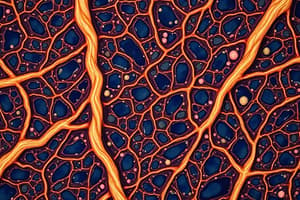Podcast
Questions and Answers
Quel est le rôle principal des macrophages ?
Quel est le rôle principal des macrophages ?
- Contribuer à l'élasticité des tissus
- Englobir et digérer les particules étrangères, les bactéries et les cellules mortes (correct)
- Produire des anticorps contre les pathogènes
- Fournir un soutien mécanique aux autres tissus
Quelle est la fonction principale du tissu conjonctif ?
Quelle est la fonction principale du tissu conjonctif ?
- Transporter l'oxygène
- Fournir un support mécanique aux autres tissus (correct)
- Digérer les aliments
- Produire des hormones
Quelle est la principale protéine trouvée dans la matrice extracellulaire ?
Quelle est la principale protéine trouvée dans la matrice extracellulaire ?
- Le collagène (correct)
- Les protéoglycanes
- Les glycosaminoglycanes
- L'élastine
Quel trouble est caractérisé par une production affaiblie de collagène ?
Quel trouble est caractérisé par une production affaiblie de collagène ?
Quelles cellules sont impliquées dans les réponses immunitaires contre les pathogènes ?
Quelles cellules sont impliquées dans les réponses immunitaires contre les pathogènes ?
Quel est l'un des quatre types de tissus de base chez les humains, selon le texte?
Quel est l'un des quatre types de tissus de base chez les humains, selon le texte?
Quel type de cellule est responsable de la production de collagène et d'élastine dans le tissu conjonctif?
Quel type de cellule est responsable de la production de collagène et d'élastine dans le tissu conjonctif?
Quelle est la fonction principale des mastocytes dans le tissu conjonctif?
Quelle est la fonction principale des mastocytes dans le tissu conjonctif?
Quelle est la principale fonction du tissu osseux selon le texte?
Quelle est la principale fonction du tissu osseux selon le texte?
Quel type de tissu sert de liaison entre les muscles et les os?
Quel type de tissu sert de liaison entre les muscles et les os?
Flashcards are hidden until you start studying
Study Notes
Connective Tissue and Histology
Histology refers to the study of the microscopic structure of biological tissues. One of the main types of tissue studied under histology is connective tissue, which plays a vital role in providing support, protection, and communication within the body. This article will delve into different aspects of connective tissue, including its cellular components, extracellular matrix, functions, and disorders associated with this type of tissue.
Types of Tissues
Connective tissue forms one of the four basic tissue types in humans, along with epithelial tissue, muscle tissue, and nervous tissue. Each tissue type retains its fundamental character wherever it occurs. For instance, bone represents specialised connective tissue that provides strength and rigidity, while cartilage provides flexibility and shock absorption around joints. Similarly, tendons and ligaments serve as transitional tissues between muscles and bones, allowing for movement and stability.
Cell Types in Connective Tissue
The principal cell types found in connective tissue include fibroblasts, adipocytes, mast cells, macrophages, and lymphocytes. Fibroblasts are responsible for producing collagen, elastin, and other structural proteins that form the extracellular matrix. Adipocytes store fat and provide energy storage. Mast cells participate in inflammation by releasing chemical mediators called histamine. Macrophages serve as phagocytic cells, engulfing and digesting foreign particles, bacteria, and dead cells. Lymphocytes are white blood cells involved in immune responses against pathogens.
Extracellular Matrix
The extracellular matrix (ECM) of connective tissue is composed of fibers and ground substance. The most common protein found in the ECM is collagen, which provides tensile strength and maintains tissue integrity. Elastin also contributes to the ECM's mechanical properties, ensuring flexibility and recoil. Additionally, glycosaminoglycans, proteoglycans, and glycoproteins contribute to the hydrated network of the ECM, influencing cell processes like adhesion and migration.
Connective Tissue Functions
Connective tissue serves several essential functions in the body, including providing mechanical support to other tissues, allowing for communication between cells (e.g., blood vessels), and participating in inflammation and immune responses. Inflammatory cells involved in immunological defense are found within connective tissue.
Connective Tissue Disorders
Abnormalities or disorders in connective tissue can lead to a range of health issues. For example, Ehlers-Danlos syndrome is characterized by weakened collagen production, leading to joint hypermobility and skin that bruises easily. Marfan syndrome affects the elasticity of connective tissue, causing abnormal growth patterns in the skeletal system and cardiovascular system. These examples illustrate the importance of proper functioning of connective tissue in maintaining overall health and integrity.
Studying That Suits You
Use AI to generate personalized quizzes and flashcards to suit your learning preferences.




